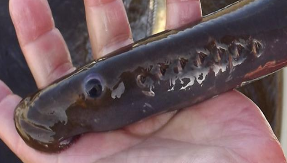Council Approves Next Phase of Lamprey Research
- August 24, 2018
- John Harrison

The next phase of a project to attempt to restore Pacific Lamprey to Columbia River tributaries, where preliminary work appears to be successful, was approved this month by the Council.
For more than a decade, the Umatilla and Yakama tribes and the Columbia River Inter-Tribal Fish Commission have been conducting research into the feasibility of using artificial propagation and translocation techniques to better understand and ultimately restore Pacific Lamprey to their historic range, focusing on the Columbia River Basin population. Now the exploratory effort is moving to a new phase that will include test releases of lamprey larvae into the Yakima, Naches, Tucannon, and Walla Walla rivers. Adult lamprey raised in hatcheries will be released into the Methow, Yakima, Umatilla, and Grand Ronde rivers. The purpose is to test whether lamprey raised in hatcheries can survive in the wild.
Lamprey are a culturally important species for the tribes and also a food source for seals, sea lions, and fish-eating birds. Lamprey populations vary from year to year, but numbered well over 100,000 per year counted at Bonneville Dam in the 1960s to about half that or less in recent years, according to information compiled by the Fish Passage Center.
The work approved by the Council is part of the Pacific Lamprey Artificial Propagation, Translocation, Restoration, and Research Plan, known as the lamprey master plan, developed by the Yakama, Umatilla, and Nez Perce tribes and the Columbia River Inter-Tribal Fish Commission. It is anticipated that the cost of the lamprey effort for the next five years, which includes three separate projects that implement parts of the master plan, will range from about $100,000 to $350,000 per year; the Umatilla Tribes’ work is expected to cost around $671,000, and the Yakama Nation’s project is expected to cost around $304,600.
In its approval, the Council noted that the master plan and associated projects developed by the tribes are important and asked Bonneville and the tribes to assess whether adequate funding is available. Bonneville Administrator Elliott Mainzer told the Council at two meetings this year that he anticipates cutting costs agency-wide to keep its electricity priced competitively. Brian McIlraith, Pacific lamprey project leader for the Inter-Tribal Fish Commission, told the Council that while there is concern about Bonneville’s financial outlook, the tribes are motivated to implement the master plan and that they are working to keep costs down including, for example, by raising lamprey at existing salmon hatcheries. Council approval also came with a favorable review of the lamprey work by the Independent Scientific Review Panel, and a condition that the panel review the program again in 2022.
Currently it is not known if raising lamprey in hatcheries and releasing them into the wild can achieve long-term restoration of the species in the Columbia River Basin, but experimental outplantings of hatchery-bred lamprey to date appear to have been successful. The lamprey recovery effort is a long-term undertaking. The first phase, from 2012-2020, is intended to determine whether it is feasible to spawn and rear significant numbers of Pacific Lamprey in a hatchery. The second phase, from 2018-2026, the phase approved this month by the Council, includes supplementation and biological research such as planting adult and juvenile lamprey and larvae for migration and passage research, testing and improving dam-passage facilities for lamprey, and also determining whether hatchery-produced fish can adapt to natural conditions. The third phase, 2022-2029, proposes to develop restoration actions based on supplementation research, develop lamprey planning activities and determine next steps toward recovery. The final phase, 2027-2029, would use a combination of dam-passage improvements, habitat improvements, and hatchery actions to develop naturally self-sustaining lamprey populations.


